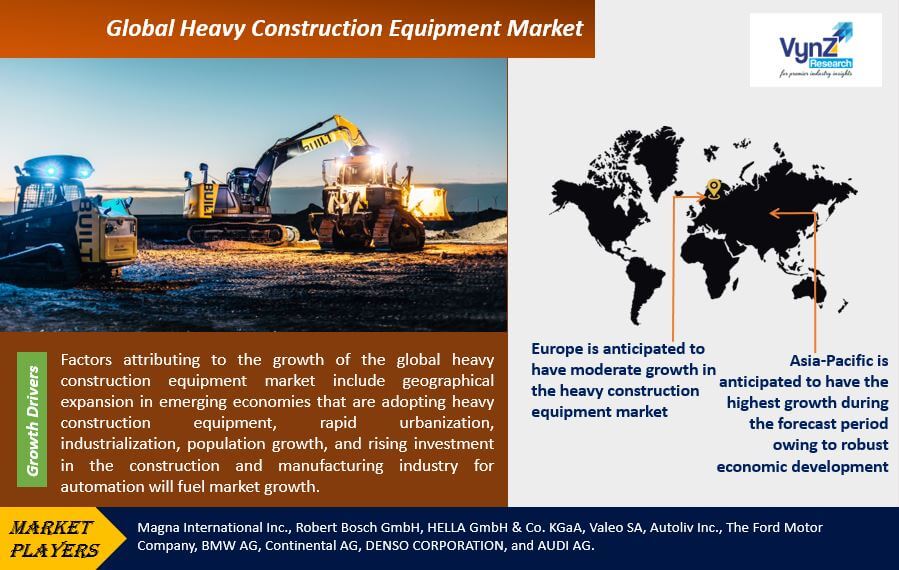Industry Overview
The Global Heavy Construction Equipment Market was valued at USD 180.3 billion in 2023 and is anticipated to reach USD 277.5 billion by 2030, witnessing a 5% CAGR during the forecast period. Heavy construction equipment also called large-scale machinery is used to speed up processes, boost efficiency on a large scale, and decrease the demand for labor. Heavy machinery, construction equipment, and heavy-duty vehicles are all examples of heavy construction equipment. Large civil projects, as well as residential and commercial building construction of any scale, require the use of heavy vehicles. Excavators, dump trucks, bulldozers, motor graders, etc are some of the tools used in heavy construction equipment. These tools are made to handle a variety of jobs, including demolition, construction, open-pit mining, material handling, and earthmoving. Nevertheless, the market is expanding as a result of the integration of Internet of Things (IoT) devices with construction equipment to enhance equipment performance and aid in task monitoring.

The burgeoning real estate market in the US will probably lead to more infrastructure development projects in areas like Austin, Seattle, Fort Lauderdale, and Dallas. Without question, this will have a significant impact on the heavy construction market as a whole.
Heavy Construction Equipment Market Segmentation
Insight by Equipment Type
Based on Equipment Type, the Global Heavy Construction Equipment Market is segmented into Earthmoving Equipment, Material Handling, Heavy Construction Vehicles, and Others. Earthmoving Equipment includes Excavators, Loaders, Backhoe loaders, Motor Graders, Dozers, and Others. Material Handling includes Cranes and Telescopic Handlers. Heavy Construction Vehicles include Dumpers and Tippers.
Earthmoving Equipment contributes the largest share of the heavy construction equipment market due to the increased adoption of heavy-duty vehicles in mining and construction activities for moving or relocating heavy rocks, mud, debris, and materials. Moreover, there is more demand for earthmoving equipment in developing countries like Indonesia, India, and Malaysia owing to massive investment in the development of transport infrastructure.
Insight by Application
Based on Application, the Global Heavy Construction Equipment Market is segregated into Excavation & Demolition, Heavy Lifting, Tunneling, Material Handling, and Recycling & Waste Management. Excavation and Demolition are anticipated to have a high CAGR during the forecast period due to the spur in the exploration of mining activities for precious metals globally and rising natural calamities where excavators are used for rescue operations.
A high growth rate in revenue is anticipated for the recycling and waste management segment over the forecast year due to advantages such as decreased disposal costs, enhanced effectiveness, and better resource and energy usage. Due to a growth in recycling operations, there is a strong need for heavy equipment managing waste management.
Insight by End-Use Industries
Based on End-Use Industries, the Global Heavy Construction Equipment Market is categorized into Infrastructure, Construction, Mining, Oil and Gas, Manufacturing, Forestry, Agriculture, and Others. The mining segment is anticipated to grow significantly during the forecast period as industries depend on mining for the extraction of major raw materials, minerals, and metals. mining also lays the groundwork for modern living as mined resources are used to construct hospitals, roads, and houses, make automobiles, generate electricity, and make computers, and satellites. Heavy machinery that is frequently utilized in the mining sector includes haul trucks, wheel loaders, drill rigs, and crushers. Also, the mining industry makes extensive use of heavy machinery like drill rigs because they offer advantages such as improved safety, maneuverability, productivity, and mobility.
Global Heavy Construction Equipment Market Report Coverage
|
Report Metric
|
Details
|
|
Historical Period
|
2018 - 2023
|
|
Base Year Considered
|
2024
|
|
Forecast Period
|
2025 - 2030
|
|
Market Size in 2024
|
U.S.D. 180.3 Billion
|
|
Revenue Forecast in 2030
|
U.S.D. 277.5 Billion
|
|
Growth Rate
|
5%
|
|
Segments Covered in the Report
|
By Equipment Type, By Application, and By End-Use industries
|
|
Report Scope
|
Market Trends, Drivers, and Restraints; Revenue Estimation and Forecast; Segmentation Analysis; Impact of COVID-19; Companies’ Strategic Developments; Market Share Analysis of Key Players; Company Profiling
|
|
Regions Covered in the Report
|
North America, Europe, Asia-Pacific, Middle East, and Rest of the World
|
Industry Dynamics
Heavy Construction Equipment Market Growth Drivers
Factors attributing to the growth of the global heavy construction equipment market include geographical expansion in emerging economies that are adopting heavy construction equipment, rapid urbanization, industrialization, population growth, and rising investment in the construction and manufacturing industry for automation will fuel market growth. Moreover, the surge in investment in the infrastructure sector due to a rising number of construction activities along with rising demand from the residential sector and increased trend for rental or leasing services of heavy equipment will spur the market demand for the heavy construction equipment industry.
The market size for the heavy construction equipment industry is also being driven by initiatives like the development of smart cities, the building of roads and rails, the construction of bridges, and other mining activities. Moreover, there is a need to have proper quality and timely completion of work on these construction projects. Thus, the best possible utilization of resources and labor is made possible by heavy machinery like backhoe excavators, etc. Another reason fueling the market's expansion is the need for replacement, maintenance, or repair of aging infrastructure.
Investments in the construction industry have been spurred by the continuously rising costs of residential properties and the increased demand for residential homes. A strong emphasis on automating the manufacturing process should benefit the global sector. In response to the spike in road development plans implemented by various state and central governments, the market for road construction machinery will experience significant growth.
Heavy Construction Equipment Market Challenges
The key reason limiting the overall expansion of the heavy construction equipment business is considered to be the fluctuating cost of oil and fuel that are used to operate heavy machinery, as well as the increasing carbon footprint while running the machines.
Moreover, there is a need to have huge funds for construction projects, mining activities, and industrial activities that may pose a challenge for the industry players in the heavy construction equipment market. In comparison to industrialized countries, it is expected that these industries in emerging nations will have financial constraints. This can indicate a slowdown in future market demand.
Also, for the proper functioning of heavy construction equipment, skilled labor is needed. Secondly, buying new equipment is expensive. Furthermore, as the business must invest in both labor and equipment, training new employees adds to the expense. The market size for heavy construction equipment is also predicted to be constrained by these factors over the projected period.
Heavy Construction Equipment Market Opportunities
- Heavy construction equipment is considered to play a significant role in lowering construction project costs by boosting output and ensuring on-time project completion, particularly for large contracts.
- Additionally, renting heavy construction equipment has become increasingly popular because renting such equipment is more affordable than purchasing it. Where there is a lack of skilled labor, these tools are crucial to maintaining production rates.
These all factors will provide tremendous market opportunities for growth in the heavy construction equipment market.
Heavy Construction Equipment Market Geographic Overview
- North America
- Europe
- Asia Pacific (APAC)
- Rest of the World (RoW)
Asia-Pacific is anticipated to have the highest growth during the forecast period owing to robust economic development and the presence of major key players in the region that are inclined towards adopting innovations, thereby propelling the market growth of the heavy construction equipment industry in the region. Furthermore, favorable government policies and increased funding by the government will push the market growth of the heavy construction equipment industry.
Europe is anticipated to have moderate growth in the heavy construction equipment market owing to impending plans and activities for several construction projects. During the projection period, significant projects such as port extensions and underwater tunnels that connect the major regions of European countries will provide profitable prospects for the overall expansion of the heavy construction equipment sector.
Heavy Construction Equipment Market Competitive Insight
The market is highly competitive. To enhance their market share, competitors have begun offering refurbished equipment backed by warranty certificates. The key players operating the heavy construction equipment industry are emphasizing investing in developed, smart, and fuel-efficient technologies to work on procedures that require less labor and cost. Thus, to increase their respective product portfolios and establish a solid footing in the global market, key players are working on new products and forming strategic alliances.
Komatsu is one of the prominent manufacturers of heavy equipment for the construction, mining, forestry, and industrial markets. The entire Komatsu product line offers exceptional durability and reliability and will continue to assist customers in meeting their business objectives by providing high-quality heavy equipment that increases productivity and lowers operating costs. Their products include blast hole drills, crushing, dozers, draglines, electric rope shovels, entry development, excavators, room and pillar, forestry, shaft sinking equipment, forklifts, hybrid mining shovels, underground hard rock bolters, longwall, underground hard rock drills, motor graders, wheel loaders, and underground hard rock haulage.
Construction equipment made by Cat offers the durability and performance required to complete any task quickly and efficiently. Cat machines offer efficiency that keeps expenses under control as well as productivity and generates profits for the company. They are robust and adaptable enough to handle demanding situations. Their product portfolio includes motor graders, excavators, dozers, wheel loaders, skid steer loaders, backhoe loaders, and more.
Recent Development by Key Players
Caterpillar Inc. has introduced its newest innovation to the heavy equipment industry, the Cat 973 track loader. This colossal machine promises unparalleled performance and efficiency, catering to the evolving needs of construction projects worldwide.
Liebherr (German-Swiss multinational equipment manufacturer) has announced that deliveries of its first-ever electric compact wheel loader, the L 507 E. The Liebherr L 507 E compact wheel loaders were announced last summer, and have been available for order since October. And, while no timeline has been set, chances are good that the battery-powered machine will eventually make its way across the Atlan.
Key Players Covered in the Report
The major players in the global heavy construction equipment industry include Caterpillar, LIEBHERR, Komatsu Ltd., Deere & Company, SANY Group, Hitachi Construction Machinery Co., Ltd., Hyundai Doosan Infracore, AB Volvo, CNH Industrial N.V. and Terex Corporation.
The Heavy Construction Equipment Market report offers a comprehensive market segmentation analysis along with an estimation for the forecast period 2025–2030.
Segments Covered in the Report
- By Equipment Type
- Earthmoving Equipment
- Excavators
- Loaders
- Backhoe loaders
- Motor Graders
- Dozers
- Others
- Material Handling
- Cranes
- Telescopic Handlers
- Heavy Construction Vehicles
-
Others
- By Application
- Excavation & Demolition
- Heavy Lifting
- Tunneling
- Material Handling
- Recycling & Waste Management
- By End-Use Industries
- Infrastructure
- Construction
- Mining
- Oil and Gas
- Manufacturing
- Forestry
- Agriculture
- Others
Geographical Segmentation
- North America
- Europe
- Germany
- U.K.
- France
- Italy
- Spain
- Russia
- Rest of Europe
- Asia-Pacific (APAC)
- China
- Japan
- India
- South Korea
- Rest of Asia-Pacific
- Rest of the World (RoW)
- Brazil
- Saudi Arabia
- South Africa
- U.A.E.
- Other Countries
.png)




.png)